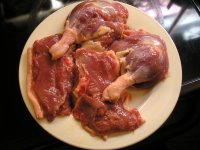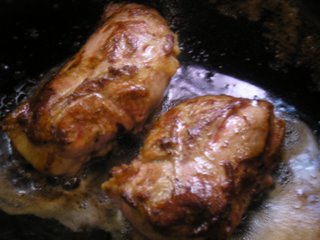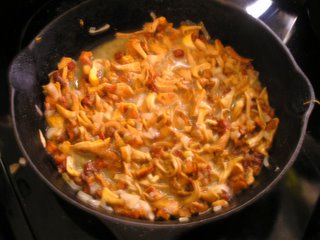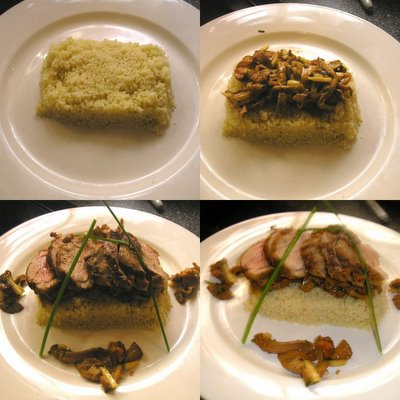Duck, Covered

The first time I cooked duck was around 8 years ago when I made a tea-smoked duck in the oven.
That was fun.
That was when we lived in Daly City and when I was bitten in a big way by the Cantonese Roast Duck bug, and gained about 20 pounds from the one-two combination of melting duck fat/crispy skin and plum sauce.
Arrrrr. I'm drooling just thinking about it.
Fortunately, for my health and for my wallet, that didn't last too long.
Recently, I bought a duck (or to be accurate, a duckling) on a whim. It was when we were at O'Briens in Modesto (a fantastic, family-owned supermarket!) and I happened to notice they had duckling for sale at a reasonable price ($2.29 per pound). So I bought one, not really sure about what I was going to do with it.
Just so happens that Bruce's niece's husband, Jeremy, had been out hunting for duck that same day and bagged him one.
It felt good knowing that both of us had exerted so much time and energy hunting down the thing we love most.
Him in his green and brown camoflage.
Me in my black dress shirt and jeans.
Him, crouched down in some muddy field at the butt-crack of dawn.
Me, stalking the clean supermarket aisles in the middle of the afternoon.
Him, dodging snakes, bugs, crazy hunters.
Me, little old ladies with pushcarts.
In the end, he had to clean his duck; pulling out feathers, draining off the blood, pulling out buckshot. All I had to do was cut open the plastic bag.
And cut with GUSTO I did!
I ended up finding a recipe for Pan-Grilled Duck Breast with Chanterelles, Dried Apricots, and Almonds in the book The Slow Mediterranean Kitchen by Paula Wolfert (are you reading this, Bill?). publisher's link
Although I made some changes, the recipe came out pretty tasty and surprisingly fast and easy.
Before I get on with the recipe, let me just say this. I thought cutting up a duck would be like cutting up a chicken; something I have done dozens of times with ease. But, oh no!
Ducks are not chickens. For one thing, the smell is completely different. Raw duck meat has a meatier smell to it than chicken.
Also, ducks are a *bitch* to cut up. There's all kinds of bones and cartiledge where you think there shouldn't be. The skin is tough and you really have to have a sharp knife to cut with. Even then, cutting up a duck can be time consuming, so I recommend cutting it up long before you start this recipe.
Tip: If you buy your duck in Chinatown, they'll cut it up for you!
 I made this recipe after I got home from work, so we weren't eating until 8 PM. However, if I had the duck breasts washed, dried, cut from the bird, and ready to go, it would've shortened my time a good 30-45 minutes. Again, part of that time was figuring out where and how to cut and then trying to cut through all of that tough fat and skin. The other part was cutting up the rest of the bird since I was getting off the fat and the legs for the confit I was making on Saturday and Sunday. The leftovers had to be put in bags marked "duck" and stuck in the freezer.
I made this recipe after I got home from work, so we weren't eating until 8 PM. However, if I had the duck breasts washed, dried, cut from the bird, and ready to go, it would've shortened my time a good 30-45 minutes. Again, part of that time was figuring out where and how to cut and then trying to cut through all of that tough fat and skin. The other part was cutting up the rest of the bird since I was getting off the fat and the legs for the confit I was making on Saturday and Sunday. The leftovers had to be put in bags marked "duck" and stuck in the freezer.The other thing I learned that I'd like to share is exactly, "what is Duck". Or, what is that thing I bought in a bag labelled "duck".
First, it's not really a duck, but a duckling. That means it's baby duck (aww!) who's life was cut tragically short at the tender age of 7 to 11 weeks so that you and I could have pan-grilled duck breasts. (awwww!)
If you bought that duckling in the United States and it came already packaged in that heavy plastic covering, and it just said "duckling", chances are it is a White Pekin duck. White Pekin duck is the same as Long Island duck, and was brought to the United States from China in 1873 where it was then commercially raised in, where else, Long Island.
Coincidentally, the Soprano family arrived in America that same year and shortly set up shop selling "New Jersey ducks" that, in their darling colloquialisms, "beats da fuckin' pants off dohs pussy Lawn Guyland pigeons!".
By the 1940's, Long Island duck farms produced 6.5 million ducks annually. Today, there is only one duck farmer left in Long Island, mostly due to pollution and poor waste management that drove most duck farmers out of business.
Special Note: White Pekin is a duck. Peking duck is a Chinese dish that dates back over 700 years.
White Pekins make up roughtly 95 percent of the ducklings sold for food here with the other two, Muscovy and Moulard (a cross between Muscovy and White Pekin), making up the rest of the market. Muscovy is the duck (liver) used in making foie gras and whose breast meat is generally considered superior to the other species.
The fourth kind of duck eaten in the US is the wild game duck, Mallard. That's the kind Jeremy likely shot.
Also, something that use to confuse me about "breasts" is what really is the breast. But now, I think I've gotten it figured out. Often, when we think of a breast, ie chicken breast, we are really only thinking of half of the breast. But in actuality, the whole breast of a bird is both muscles on either side of the breast bone. So, remember that next time you see a place that sells you a chicken breast and only gives you half. Be sure to complain loudly; loud enough to get comped a free bottle of wine or something.
OK! Did you learn anything new?
That's nice.
Here's Paula's recipe, with my bitching added in:
Pan-Grilled Duck Breast with Chanterelles, Dried Apricots, and Almonds
Serves 2
½ pound of small chanterelles
(I used what was available, names the big ones)
1 boneless duck breast
Course salt
½ teaspoon freshly ground pepper
2 tablespoons butter
1 cup of rich chicken stock
½ cup diced dried apricots (about 5)
1 large shallot, chopped
1 tablespoon fresh lemon juice
15 whole blanced almonds
1 tablespoon minced fresh chives
1. Wash the chanterelles. Wolfert suggested dipping them in boiling water for 2 to 3 seconds, then dunking in ice water, drying them off, and then letting them sit in the fridge for most of the day. I skipped this step and merely washed whatever dirt I could off of them. By the way, my mushrooms were pretty waterlogged to begin with, but that's not a problem as I just throw them in the hot, dry pan and the water evaporates anyway.
2. I have to say, I think Wolfert makes things last much longer than she needs to. I thought slow cooking was about building flavor, but Wolfert suggests that now you take your duck breast from the fridge an HOUR before you want to cook. Come on! That's totally unecessary.
 Anyway, trim the excess fat and skin from around the breast. Dry it with papertowels. Score the skin in a crosshatch pattern, but don't pierce the flesh. Season with salt and half the pepper and wrap in plastic wrap (uh, why cover in plastic wrap again?).
Anyway, trim the excess fat and skin from around the breast. Dry it with papertowels. Score the skin in a crosshatch pattern, but don't pierce the flesh. Season with salt and half the pepper and wrap in plastic wrap (uh, why cover in plastic wrap again?).3. In a large non-stick skillet over medium-high heat, add 1 tablespoon of butter and then the duck breast, flesh side down, and cook for about 2 minutes. Add 2 tablespoons of stock to deglaze and boil until thick. Then turn over the duck breast and season with salt and pepper. Reduce the heat to medium-low and cook the breast without turning for 15 minutes.

4. Meanwhile, in a large, dry skillet set over medium-high heat, add the chanterelles. If your mushrooms are like mine, before you even get to this step you'll need to "shred" them by pulling from the top of the chanterelle and pulling down, like you were plucking a daisy. Do this until the mushroom is shredded. Now add the mushrooms to the hot pan. They'll squeek at first and then finally release their juices. Once they have released the juices and have sauteed down a bit, add the apricots, the shallot, and the remaining butter, cooking and stirring for about 5 minutes. Remove from the heat.
5. Turn the breast over and finish cooking on the flesh side. Test for doneness by poking the breast with your finger. If it's still pretty soft, it's probably still rare, so continue to cook for another 5 minutes or so. When done, remove to a plate and cover with foil.
6. Pour off all of the fat from the duck breast skillet and return to the burner. Crank up the heat and deglaze with the rest of the stock. Add the mushroom mixture, correct the seasonings, add the lemon juice (or leave it out, because I didn't add the lemon and my sauce was citrusy enough) and then add the almonds and the chives.

Another note here: I didn't have almonds handy, and if I did, I didn't have time to blanch any. Instead, I used slivered almonds and they worked out just fine.
7. This is the end of the recipe. All Wolfert tells you here is to thinly slice the duck breast, season, and serve with the mushroom sauce…but on what? Is that it?
I decided to whip up some couscous, which is super easy. After it was cooked, I plated it, then topped with the mushroom sauce, then the duck breast. Throw on a few unchopped chives for décor and voila!

God, I love duck!
k.
 Hello and welcome. This food blog is based in San Francisco and I'm Kevin, the guy who writes it.
You may know me from my brief, but violent and cracked out, appearance on COPS. Actually, that wasn't me - he didn't even look like me.
I'm more than happy to entertain you, but please don't be so shy. You can comment below or contact me personally at baconprss at yahoo dot com. Oh, and I like to eat sometimes.
Hello and welcome. This food blog is based in San Francisco and I'm Kevin, the guy who writes it.
You may know me from my brief, but violent and cracked out, appearance on COPS. Actually, that wasn't me - he didn't even look like me.
I'm more than happy to entertain you, but please don't be so shy. You can comment below or contact me personally at baconprss at yahoo dot com. Oh, and I like to eat sometimes.

0 Comments:
Post a Comment
<< Home